A long time ago, sometime between about 600 and 150 BC, Celtic tribes journeyed across the sea from western Europe and invaded Ireland. The land was lush, fertile and beautiful, a much desired location for a new home, but it was not empty. Another race had already been settled in Ireland for thousands of years. The Tuatha Dé Danann were recorded in Irish mythology as being a race with supernatural powers and god-like abilities. Whoever these people were they left their mark on the landscape, building enormous burial chambers and temples, erecting massive standing stones, and leaving behind exquisite, scrolling carvings, a style that is still duplicated today in Celtic art.
When the Celts invaded they raged war against the Tuatha Dé Danann, and though the natives were god-like in nature, they were forced to yield to the Celts’ greater numbers. It is said that they retreated to live underground in what people today call Sidhe Hills or the Faerie Mounds.
It was in one of these mounds that the story of the most famous Irish hero, Cuchulainn (Coo-hull-in), begins.
During our visit to Ireland, Ashleigh and I went out of our way to visit the Neolithic site of Newgrange. Newgrange is a prehistoric monument, built about 3200 B.C. by a people we know almost nothing about. Before its excavation in the 1960s the people of Ireland always referred to Newgrange and many of the other burial chambers around Ireland as the Faerie Hills, believing them to be the homes of the faeries or the ancient Celtic gods. What a wonderful surprise it must have been to find massive tunnels and chambers made out of huge slabs of stone within the tree-covered mound!
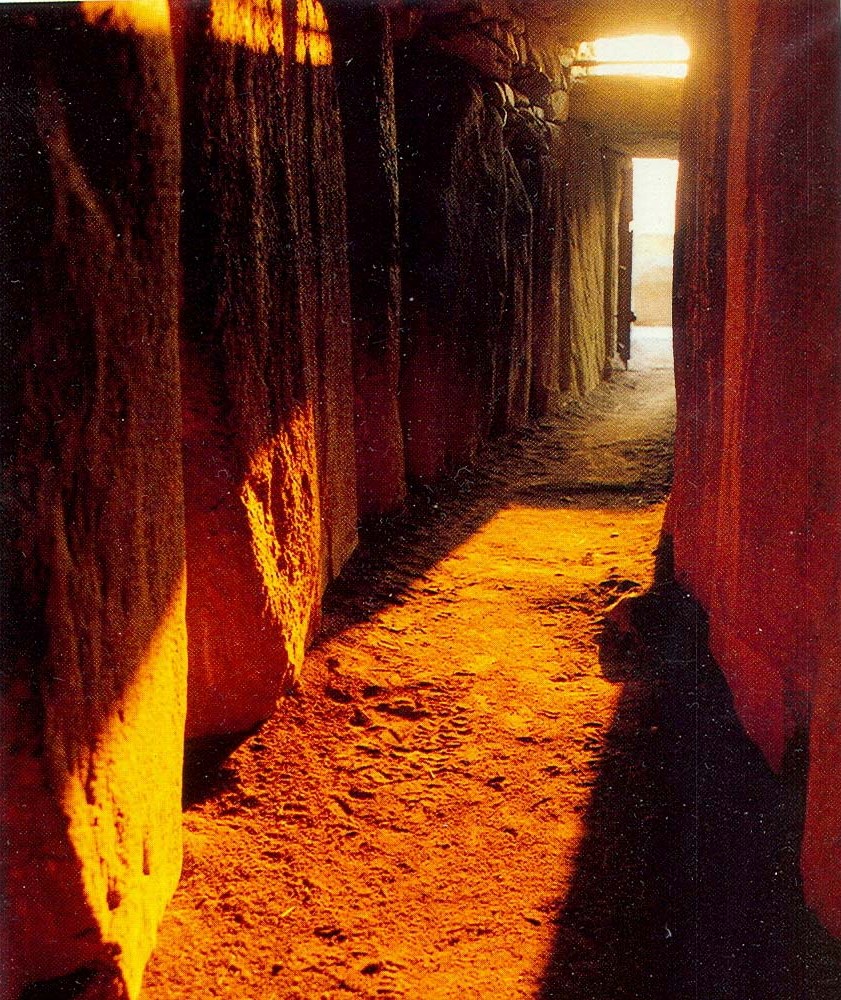
In Irish folklore, the daughter of the King of Ulster (northern province of Ireland), Deichtine, visited the tomb at Newgrange and spent the night. In a dream the Celtic god Lugh, one of the Tuatha Dé Danann, tells Deichtine that she will give birth to his son who is to be called Sétanta.
Sétanta was born in what was once called the Murtheimne Plains and is now the county of Louth. In Louth they pride themselves on being the region where most Irish legends and folklore are set, but to the people of Louth it’s not considered folklore… it’s history.
![]()
Sétanta wasn’t born an ordinary child. He was better than most people at mostly everything. While at home with his parents in Murtheimne Plain, the five-year-old Sétanta heard exciting rumours about a fighting school in Armagh. It was run by the King Conchobhar of Armagh to train the best young boys of the day to be great warriors for Ulster. Sétanta knew that his destiny was to become a great warrior, so, without his mother’s permission, he set off with a toy shield, toy javelin, and a hurling stick and sliotar (hurling has been Ireland’s national sport for centuries). For fun on the journey, he would throw his javelin ahead of him and catch it again before it hit the ground.
After a long journey Sétanta finally arrived at the fighting school and saw a group of the older boys playing a game of hurling on the fields stretching in front of King Conchobhar’s castle. Sétanta joined in the game and beat the older boys, making them furious that such a young child could steal their game. They all advanced to attack Sétanta, but a battle-fury took him and he flattened all fifty of the older kids. The King had to come down from his castle just in time to rescue them from Sétanta’s wrath.
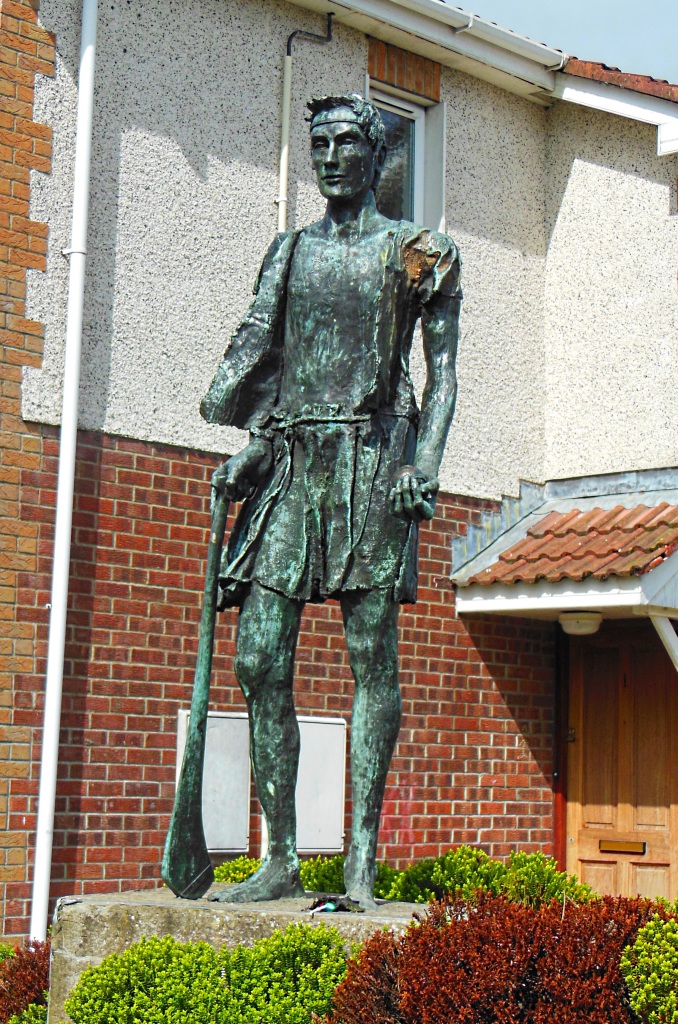
Having witnessed Sétanta’s incredible strength and fiery will, King Conchobhar accepted him into the school. Sétanta then made peace with the other boys and offered them his protection.
One evening, the King was holding a special feast for all the adult warriors at the home of the blacksmith Culann, and decided to invite Sétanta to meet everyone. Sétanta was busy playing a hurling game as a one man team (and winning) and said he wouldn’t be able to make the feast until later that night.
By the time Sétanta finally arrived at the house of Culann everyone had completely forgotten about him. The blacksmith Culann released his guard hound, a mighty black beast of a dog, to keep watch for the night. Sensing Sétanta’s approach the black dog moved in for the kill. Culann’s hound attacked Sétanta, who only had with him his hurling stick and ball (sliotar).
When King Conchobhar saw the guard hound take off into the night, he suddenly remembered about Sétanta and rushed outside hoping he wouldn’t find the child’s body torn to pieces. What he did find, to his relief, was Sétanta standing proudly with one foot on the gigantic hound. The guard dog lay dead with Sétanta’s sliotar ball shoved down its throat.
In recompense for Culann the blacksmith’s dead guard dog, Sétanta promised to take it’s place as a guard until Culann was able to get a new one. From that day forth the young hero Sétanta was renamed Cú Chulainn, Culann’s Hound.
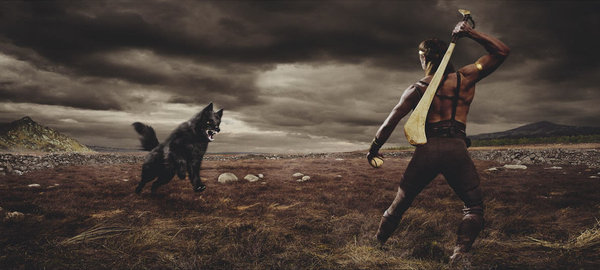
We tracked down Cúchulainn’s birthplace to the modern town of Dundalk in County Louth, and then to the fortress nearby, which has been renamed Cúchulainn’s Castle. Apparently the original town of Dundalk, Dún Delga, had been built around the site, so if Cúchulainn did indeed exist it is quite possible he was born there. From the steep hill of the fortress I could see the river and the surrounding countryside and I tried to imagine what the town would have once looked like surrounding it. In town, it seemed like everything was named after their folk hero; there were statues, art and plaques devoted to Cúchulainn, his legend still inspiring the people of today.
Cúchulainn grew up to be an incredible warrior, he was unmatched by all and his enemies feared him. Throughout his lifetime he accomplished many amazing deeds and went on many adventures, but the most popular tale of Cúchulainn is known as the Cattle Raid of Cooley.
Queen Medb ruled over Connacht, and when Ailill married her, he became her king. They were both very powerful and proud rulers. One night, they were sitting in bed squabbling. Ailill said to Medb, ‘It strikes me how much better off you are today than the day I married you.’ Medb’s father had been the High King of Ireland, so she was a very rich woman. She was offended that Ailill thought he was wealthier. The argument continued on throughout the night until the couple commanded their servants to bring out all their wealth to prove who indeed was the richest. From animal skins to gold and jewels, they hauled out their loot until there was nothing left, but still they were both equal in wealth. Finally Ailill called for his great, white horned ‘Finnbennach’, a stud bull of incredible pedigree. Medb had to agree that she did not own a bull to match Ailill’s. In fact, there was only one bull in the whole of Ireland that did, and it belonged to an Ulster man called Daire Mac Fiachna. Medb immediately dispatched her servants to Ulster asking Daire for the loan of the bull for a year.

The messengers told Daire that he would be given many riches and land in return for lending the bull. Daire happily agreed and held a great feast that night in celebration. After everyone had a few drinks, Daire overheard the messengers haughtily say amongst themselves that if Daire had refused to lend his bull Medb would have taken it by force any ways. Daire grew furious at hearing this and kicked the messengers out of his home saying that Queen Medb would never have his bull.
And so began the Cattle Raid of Cooley. Queen Medb raised an unstoppable army and marched on to Ulster to take what she wanted. King Ailill also called together his forces to join his wife. Most of Ulster’s best warriors were suffering from the terrible pangs of Ulster, a curse that had been placed upon them by a goddess, and were unable to rise to fight. Medb felt very confident on her victory.
But there was on anomaly that Medb failed to consider. There was Cúchulainn. Unharmed by the curse, the 17-year old warrior strode forth to face the army of Medb and defend Ulster, his homeland. With guerilla tactics, Cúchulainn, killed off hundreds of Medb’s men everyday, with his sling, all alone.
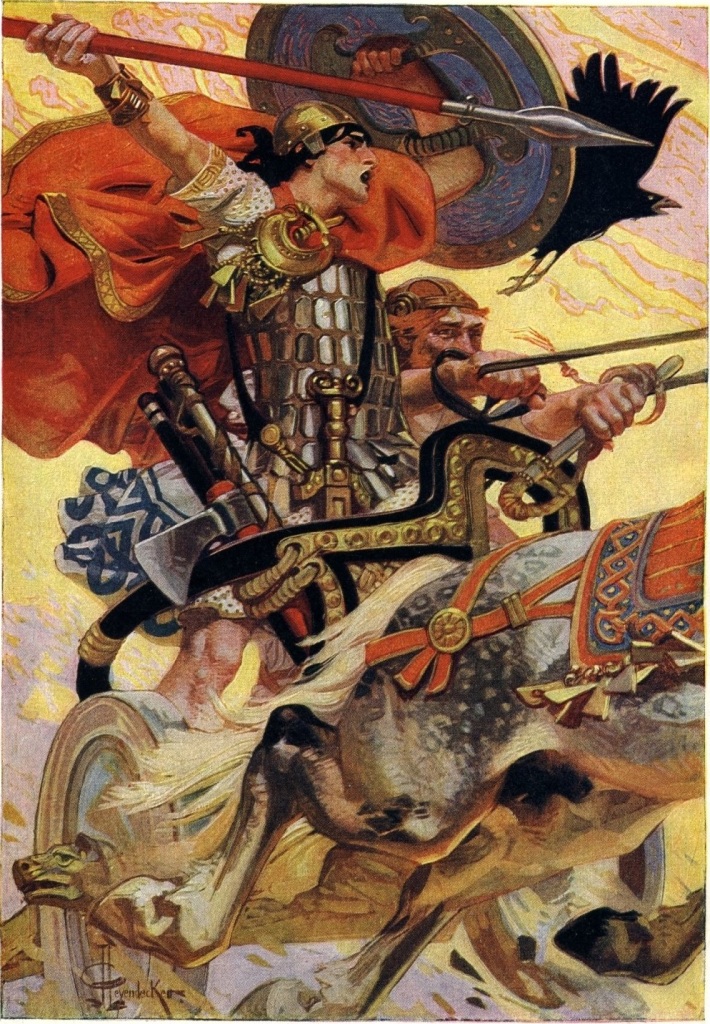
Medb became very anxious. She offered Cúchulainn money, land, and women to convince him to change sides, but he refused them all. Instead, he promised to stop attacking the army if they sent one champion to fight him every day and if Medb would agree not to take any cattle, nor move position, until he was beaten. Medb agreed. Day after day Medb sent a champion to defeat Cúchulainn, but he slaughtered them all.
Finally Medb ordered Ferdiad to fight. Ferdiad had been a brother in arms to Cúchulainn, trained by the same master and they had fought together in many battles. They were good friends, but Ferdiad had no choice, he had to obey his queen.
The fight between the two warriors raged on for five days. Each day brought a new choice of weapon. The whole of Ireland was enraptured by the gruelling contest. Finally, Ferdiad found a way through and pierced Cúchulainn’s chest with his sword. In a fury, Cúchulainn grabbed his spear and hurled it through Ferdiad’s body.
Cúchulainn was wounded and deep in despair from having to kill his best friend, and was unable to continue fighting. But it was around this time that the men of Ulster awakened from their curse. Because Cúchulainn was able to stall Medb’s army long enough, the men of Ulster had time to recuperate and attack. What was left of Medb’s army was forced to retreat empty handed, and the land of Ulster was saved, all because of one man.
It was in the modern town of Ardee of the County Louth where Cúchulainn defended the ford of the river Dee from Medb’s army, defeating champion after champion. Ashleigh and I bussed to this area and spent the day walking around this lovely village. Near the bridge over the Dee River is believed to be the site where Cúchulainn and Ferdiad fought for five days. In that place the people of Ardee have erected a statue of Cúchulainn holding the body of his best friend, Ferdiad, in his arms.
The last place Ashleigh and I visited on our trip through Louth was Cúchulainn’s standing stone near the tiny village of Knockbridge. It took us a while to find it, but at last, after asking several people, we found the stone in the middle of a farmer’s field. A standing boulder that had been raised by the Stone Age tribes of Ireland, it is also the final resting place of the Irish hero Cúchulainn.
Many years after the Cattle Raid of Cooley, Cúchulainn had acquired a great deal of enemies. Queen Medb, whose pride had been deeply wounded at her defeat in the War of the Brown Bull, sought to get her revenge. She held meetings with the families of those slain by Cúchulainn, she kept on at them to seek revenge for the deaths of their loved ones against the Champion of Ulster. With all of these powerful families conspiring against Cúchulainn, they finally managed to get the best of him. They killed his horse, his charioteer, and at last mortally wounded the hero. With his last bit of life, Cúchulainn managed to drag himself to a standing stone and tied himself to it so that he would die standing, facing his enemies. No one dared to approach his body until a raven landed on Cúchulainn’s shoulder and the hero light faded from his face, signifying his death. But even when his enemies moved to take his head as a prize, Cúchulainn’s arm fell, holding a sword, and chopped off one of their hands.
The Legend of Cúchulainn was a tale I’ve read since I was a kid, and being in Ireland, following Cúchulainn’s story, was a wonderful experience for me. It’s not everyday that you get the chance to walk in the footsteps of heroes.









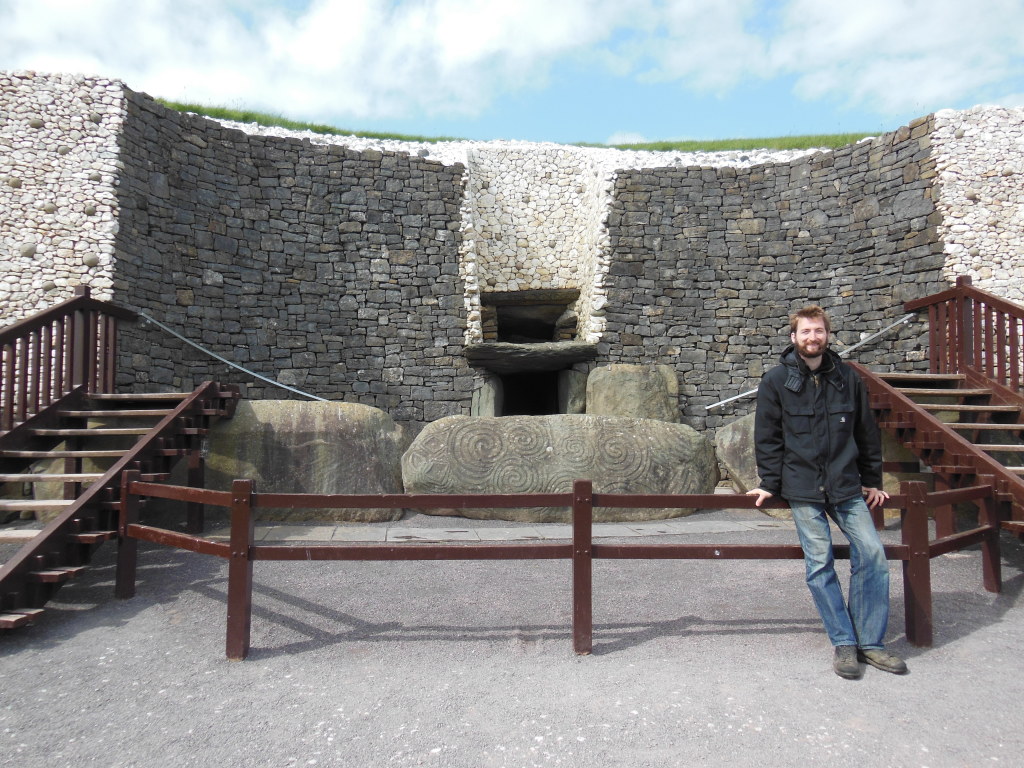

Thanks for this. A great synopsis of the life of Cú Chulainn. I live just down the road from Dundalk in Mornington near Drogheda. One interesting thing you don’t mention is the meaning of the name Ardee. In Irish it is Baile Átha Fhirdhia, or “Town of the Ford of Ferdia”, so named for Cú Chulainn’s friend. I love when modern town names have historical roots, and although I knew the Irish name of Ardee, I didn’t make the connection to Ferdiad until I read your synopsis. Thanks!
Thank you Anthony; that’s fascinating about the meaning of the name “Ardee”. It makes the legend seem all the more real.